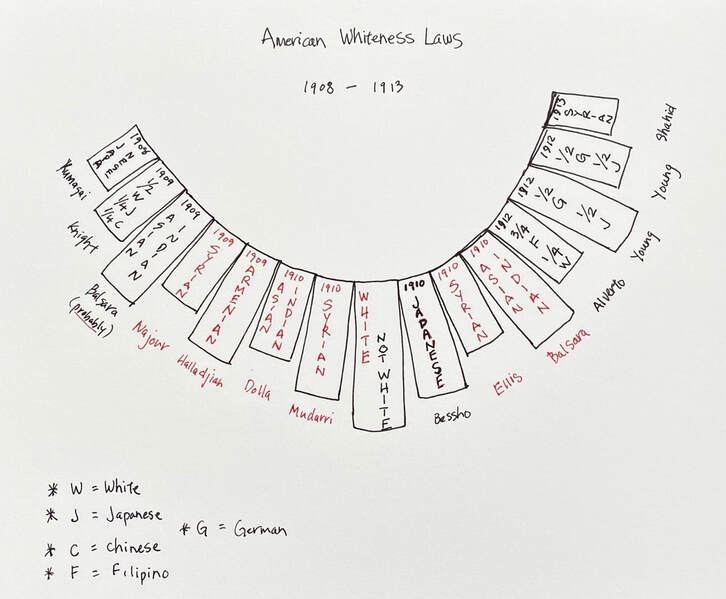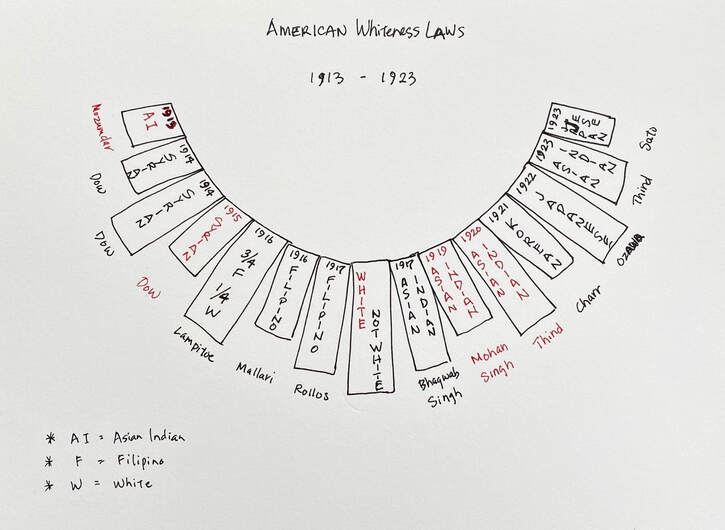|
Inspired by Supreme Court Justice Ruth Bader Ginsburg’s practice of wearing what she calls a “Dissent”Collar when she has a dissenting opinion on a ruling, I have created my own dissent collars.
|
Coming soon...
These laws have, at their base, the 1790's Naturalization Act—one of the earliest laws passed by the first US Continental Congress to determine who could and could not participate in this democracy. It said that "Any Alien"... "being a free white person"... who had "residency for two years" and was of "good character"...could naturalize.
In other words, one had to be an alien and "white.”
In the 1870's there was an attempt in congress to remove the word "white" from anywhere it appeared in our naturalization laws. The bill failed and instead a revised naturalization law was written to include "aliens of African nativity and to persons of African descent." It also added a new feature which was to revoke the citizenship of naturalized Chinese Americans.
The failure to remove the word “white" inadvertently led to the creation of a third group in addition to white and African...a new category of peoples labeled "Not-White" by law.
"Whiteness" in US Law
These pieces of “neck art” seek to examine the concept of “whiteness” in US law and how, rather than color, at issue and central to all legal race arguments was the state of being “white” (determined by common knowledge, congressional intent, scientific evidence or legal precedent ). The idea of “whiteness”—as determined by law—helped shaped who could naturalize, vote, get protection for their person and property from the government and determined who could participate fully in the “democratic” process.
The rulings of “white”, or more often than not “not white”, are based on a set of laws compiled and argued in the book White by Law: the Legal Construction of Race, by Ian Haney Lopez.
American whiteness laws were not limited to the US, but helped influence other “new” nations (Australia, South Africa and to some extent Canada, to name a few) and other empires, most notably the Nazi regime, which desired a White Christian German empire.
In other words, one had to be an alien and "white.”
In the 1870's there was an attempt in congress to remove the word "white" from anywhere it appeared in our naturalization laws. The bill failed and instead a revised naturalization law was written to include "aliens of African nativity and to persons of African descent." It also added a new feature which was to revoke the citizenship of naturalized Chinese Americans.
The failure to remove the word “white" inadvertently led to the creation of a third group in addition to white and African...a new category of peoples labeled "Not-White" by law.
"Whiteness" in US Law
These pieces of “neck art” seek to examine the concept of “whiteness” in US law and how, rather than color, at issue and central to all legal race arguments was the state of being “white” (determined by common knowledge, congressional intent, scientific evidence or legal precedent ). The idea of “whiteness”—as determined by law—helped shaped who could naturalize, vote, get protection for their person and property from the government and determined who could participate fully in the “democratic” process.
The rulings of “white”, or more often than not “not white”, are based on a set of laws compiled and argued in the book White by Law: the Legal Construction of Race, by Ian Haney Lopez.
American whiteness laws were not limited to the US, but helped influence other “new” nations (Australia, South Africa and to some extent Canada, to name a few) and other empires, most notably the Nazi regime, which desired a White Christian German empire.
To follow...
Anti-Miscegenation Laws
In addition to the American Whiteness Laws, I will include a set of ”neck art”, which will explore the role of anti-miscegenation laws (laws which outlawed the marriage or sex between different "races”), which existed in all but nine states in the US, many as late as 1967 (and later) and even predated the US in seven of the thirteen colonies.
In many of these states, the result of the mixing of the “races”, a mixed-race child, would theoretically have been born a crime.
In addition to the American Whiteness Laws, I will include a set of ”neck art”, which will explore the role of anti-miscegenation laws (laws which outlawed the marriage or sex between different "races”), which existed in all but nine states in the US, many as late as 1967 (and later) and even predated the US in seven of the thirteen colonies.
In many of these states, the result of the mixing of the “races”, a mixed-race child, would theoretically have been born a crime.
To see how these laws worked...
The following is a brief essay entitled "The Dark Side of Sunny California."
In mid-February of 2020, I was asked by the editor of The Washington Spectator to write about the State of California's recent apology to the Japanese-American community for its complicity in the Federal government's forced removal and mass incarceration of Japanese Americans during WWII. The piece compares two laws targeting two different groups of "Americans," the Native Americans in 1851 on one end and the Japanese Americans on the other, in 1942. From the beginning, the importance of being "white" was part of the state's laws, just as it was for the founding of this nation. The creation of a White Nationalist state was very much a part of this powerful state’s vision. Far from the notion that race and race laws were created and enforced only in the deep south, by rural folk and by the uneducated, these laws were very much a by-product of Northern, Western, educated urbanites.
To view the essay on The Washington Spectator website, click here.
In mid-February of 2020, I was asked by the editor of The Washington Spectator to write about the State of California's recent apology to the Japanese-American community for its complicity in the Federal government's forced removal and mass incarceration of Japanese Americans during WWII. The piece compares two laws targeting two different groups of "Americans," the Native Americans in 1851 on one end and the Japanese Americans on the other, in 1942. From the beginning, the importance of being "white" was part of the state's laws, just as it was for the founding of this nation. The creation of a White Nationalist state was very much a part of this powerful state’s vision. Far from the notion that race and race laws were created and enforced only in the deep south, by rural folk and by the uneducated, these laws were very much a by-product of Northern, Western, educated urbanites.
To view the essay on The Washington Spectator website, click here.





